This web page covers a period that S/Y Thetis sat in Pythagorio, Samos. It then covers the first leg of my solo trip back to Glyfada, a suburb of Athens, Greece which is her home port. The places I stopped are Porto Sreto in Arki, Skala in Patmos, Lera in Lipsi, Dendro in Donousa, Ayios Georgios in Iraklia, Ayios Ioannis in Paros, and Rhinia. It is illustrated with maps and photographs, and also includes some historical and geographical descriptions of the places visited as well as several links to other related web sites.
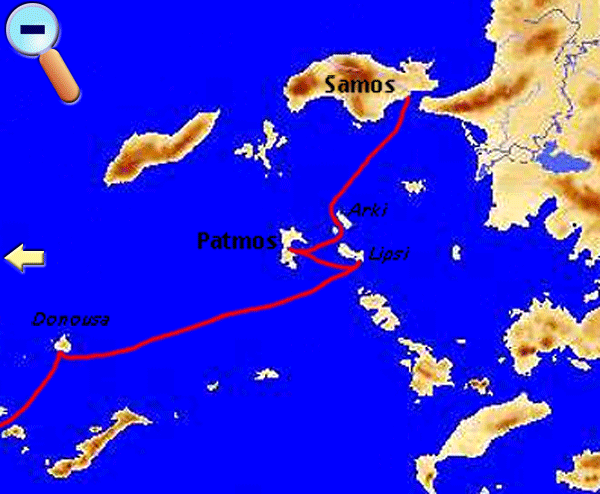
August 25 to September 11, 1999
A lot happened during this period that Thetis spent waiting for me in Pythagorio while I lived in our house in Samos, Kalami.
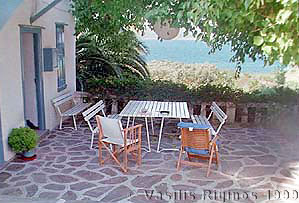
I visited Thetis every other day or so and kept her in good shape. When we arrived in Pythagorio there was a problem with charging the batteries. I had already determined that it was not caused by a faulty regulator. I connected the battery charger to the harbor’s AC power and recharged the batteries. After reading the alternator manual which suggested that ground contacts are critical, I checked all the ground contacts. Some were dirty and others a little loose. I cleaned and tightened them all. I also changed position of the regulator to give me better access to its adjustment screws. Now I was reaching the correct voltage. I was not sure whether I fixed the problem or the correct voltage was reached because the batteries were almost fully charged from the AC charger. We shall see. I changed the engine oil and oil filter. I also checked both fuel filters. The Racor pre-filter was very dirty but the primary filter was spotless. I changed the filters and filled the watermaker with biocide solution. I also filled the water tanks and removed the speed-log impeller so that it would not foul while the boat would not be moving.
Mark stayed with us in Kalami for only one day but Corinna stayed with me for 17 wonderful days. We had a quiet but good time eating lots of salads made with ripe tomatoes, freshly cut watermelons, and plenty of grapes. All of these came from our property under the care of our local magician Telemachos, who has been taking care of the property for the past 25 years. We did a lot of reading and swimming.
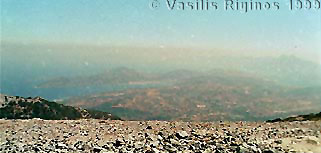
After Corinna left, my friends Sue and Yankos Krinos left their villa in Piscopio, Syros and came for a week long visit to Samos. This was their first time on the island. They had rented a car and we went to many places including the Zoodochos Pigi Monastery, The Vrontiani Monastery, Profitis Elias at the top of Mt. Karvounis, the villages of Pyrgos, Manolates, Ambelos, Marathocampos, Drakei, Mitilini, and of course the Hereon. We also walked to the waterfalls at Potami not too far from the town of Karlovasi. We all had a wonderful time, they exploring a new place, and I showing them this magical island.
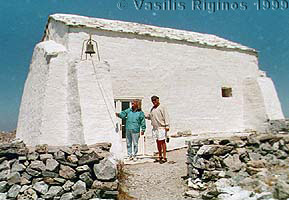
Sue & Yankos in Profitis Ilias |
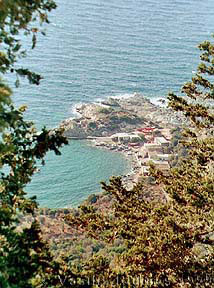
Traditional Shipyard in Samos |
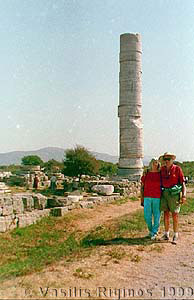
Yankos & Sue at Heraion |
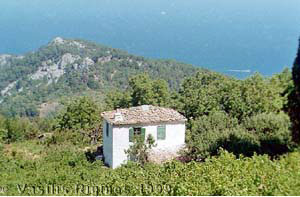
A Farmhouse in Samos |
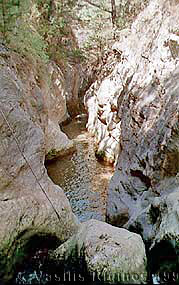
Unfortunately we also witnessed a shameful incident at the Vrontiani Monastery. While we were inside the church we heard loud and heart rendering cries from a puppy. We rushed to the monastery’s courtyard where we saw that a puppy was somehow caught and was ensnared in a wire fence. The Priest/Abbot, instead of helping the poor creature, was delivering vicious kicks while the helpless animal was crying and trying to free itself. I pushed the Abbot aside and with Sue’s help freed the puppy who immediately ran away. At the same time, Yankos, who is a most polite and proper gentleman, was delivering the most devastating dress-down to the cruel priest, all in the most proper and urbane Greek.
Also during the Krinos visit on September 7 there was a strong, 5.6 on the Richter scale, earthquake outside of Athens which damaged several factories and houses. There were over 100 fatalities. Turkey was very quick in sending relief teams thus, reciprocating for the help they got from Greece after the August 17 disaster.
After Yankos and Sue left, I too started getting ready to leave Samos. My plan was to slowly sail back to Athens, enjoying the solo cruise. However, I could not take too long getting there because I have signed up to attend a Yachtmaster course and certification examination starting on October 25 at Ft. Lauderdale, Florida.
While I was in the process of closing down the house for the winter (lots of work because everything has to be moved out of the kitchen and stored away to be safe from the extreme humidity during the winter), my friend Turgut Ayker called me from aboard New Life. He, his wife, and children were now at the end of their summer cruise to Güllük and on their way back to Çesme. We made arrangement to meet during my last night in Samos, at the cove of Poseidonio for dinner. They were going to anchor there for the night. I drove my motor-scooter and waited for them. When they were near we could talk with my portable VHF. As it was getting dark I was going to help them in the cove but unfortunately the VHF ran out of battery at the most critical time. Nevertheless they did come in and, after securing New Life, we all sat at the usually reliable Kerkezos restaurant. The shrimps stewed in a tomato sauce were really good, but the red mullets (barbounia) were not well grilled and were dry. Nevertheless, it was nice to see my friends again and to bring each other up to date on our sailing adventures. While in Güllük, Turgut had to go back to Izmir to attend to his business. So, Arzu and the kids stayed living aboard New Life as they had done in Çesme. This time, however, they got tempted by the nice weather and inviting sea. So, they pulled up her anchor and went by themselves for a day sail in the bay. As they are all good sailors, they carried it through without any difficulties. Now, I suspect, a whole new world of possibilities is opening up for them. After dinner, since the Aykers were tired from a long and arduous sail, and since I too wanted to get an early start, we said our farewells and they took their inflatable back to New Life and I rode the scooter back to Kalami.
Sunday September 12, 1999, Day 1
Finally all was ready. The houses at Kalami were closed. Dear Telemachos had loaded me with garden produce to take along the trip: tomatoes, potatoes, onions, garlic, peppers, grapes, and one watermelon. The taxi, with its reliable driver Dimitris Tsesmelis, was waiting to take me to Pythagorio while Telemachos and I hugged each other. He admonished me that I spent too much time with Thetis and not enough in Kalami.
At Pythagorio, I paid Mr. Nikos, the new harbor attendant, 2,500 GRD for the use of water and electricity and I also paid the harbor dues, about 5,000 GRD. I then said my good-byes to the guys at the Limenarchio and to Mr. Hugo of the Seafarer Charters who had kindly kept an eye on Thetis while I was at Kalami. At last, at 1100 I cast off the stern lines and started pulling up the anchor. As it often happens in Pythagorio, my anchor was fouled by another much larger anchor. Of course, like anyone who anchors often in the crowded harbors of the Greek islands, I have become an expert in extricating myself from such situations. This is done by using a short line. You tie one end of the line to a cleat in the bow and make a bow-line loop at the other end. Using the windlass, you raise your anchor and the other boat’s chain as far as you can. You then drop the looped end of the line around the offending chain. With the boat hook you catch the loop and pass it around another cleat, thus securing the chain. You then drop your anchor until it is free of the other boat’s chain. You then release your line and the chain submerges clear of your anchor.
Soon we were out of the harbor and heading towards the small island of Arki. The wind outside the harbor of Pythagorio was a breeze of 10-18 knots NE. I raised the mainsail, but I was too lazy to shake its reefs so I left it as it was in the 2nd reef. I then opened the genoa and had a very nice sail as far as Samiopoula island. At that point the wind died rather abruptly and I rolled-in the genoa, sheeted hard the main, and turned on the motor. After we had cleared Samos by 2-3 M the wind first came at 10 knots from the WNW and then slowly increased to 18-20 knots. This allowed me to have a nice close hauled-sail with the reduced genoa as far as the Arki channel.
Thetis arrived to the east cove of Porto Sreto, Arki [37° 22.4' N 026° 44.5' E] at 1540, 23.5 M. Right there at the best spot was Second Life, the German Hallberg Rassy we had met at Limnos, and then at Ayios Efstratios, and again at Sigri. They immediately recognized Thetis and waved at me. I had some trouble anchoring because the place is kind of tricky. There is a shallow patch of sand on the N side of the cove where it is best to drop the anchor at about 2 m. The trouble is that further to the N it gets shallow very quickly and at the S the depth drops very fast to over 10 m and it does not provide very good holding because it is full of weed. I succeeded on the second attempt at 3 m depth and after letting out over 30 m of chain. Thetis was floating at 12-14 m. There was a third sailboat further away.
I had a nice swim and I checked the anchor with the snorkel. It was well set. I was very pleased to be on Thetis finally alone. This year so far has been nice and adventuresome but there were too many people. It is nice finally to be quiet and all by myself. Total freedom!
The German couple from Second Life invited me over for a Campari. They are retired and are now spending 5-6 months every year aboard Second Life. Their children and grandchildren visit them. The boat is in immaculate condition. They winter her and service her in Kusadasi.
After sunset, the wind subsided. It was a lovely starlight night. I made pasta with capers (from Syros) and tuna fish. The Navtex forecast for the next day called for force 6 occasionally 7 northerlies. So, I planned to stay here and not go anywhere. Since I was sort of tired, I went to bed early.
Monday September 13, 1999, Day 2
Navtex messages received overnight:
071300 UTC Sep 99
IRAKLEIO RADIO SARWARN 92/99
WOMAN OVERBOARD FROM
CONTAINER VESSEL
"MARINCO TRADER" 9HWS
BETWEEN POSITIONS
3437N-02922E AT 052230 UTC
AND 3443N-02718E AT 060530 UTC
SHIPS IN VICINITY ARE KINDLY REQUESTED
TO KEEP A SHARP LOOK OUT FOR RESCUE
REPORT JRCC PIRAEUS
121240 UTC SEP 99
IRAKLEIO RADIO SARWARN 93/99
SPEEDBOAT "MELVITA" WITH TWO(2)
PERSONS ON BOARD IN DIFFICULT SITUATION
DUE TO ENGINE FAILURE - NOT UNDER COMMAND
REQUIRES URGENTLY ATTENTION
PSN 4NM FROM KAKIA SKALA SARONICOS GULF
SHIPS IN VICINITY
KINDLY REQUESTED TO KEEP RADIO CONTACT
WITH HER AND ASSIST IF NECESSARY
REPORT RCC PIRAEUS
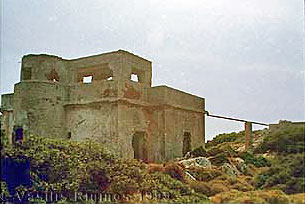
I slept well, but I was up by 7:00. After my coffee I went ashore and took a 3½ hr hike to the NW point of the island, looking for a large building which for years now I have been noticing from the sea. I found it. It is a lovely ruined villa, two stories high, a verandah on the second floor overlooking the tip of the island with magnificent views of Samos and Ikaria. The ground floor was full of goat manure. On my way back through the hamlet, I learned that the villa was built by Italians army officers before WW II, when all of the Dodecanese was occupied by Italy. Too bad that no one has restored it.
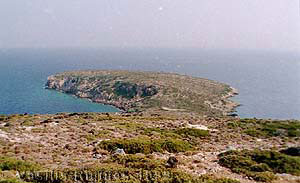
By the time I returned to Thetis the day had gotten rather hot. I had a most welcome swim and lunch under the tent. I took a long and very restorative nap. The late afternoon was cloudy but very peaceful. On this island there are large herds of sheep (hundreds of them), goats, some horses, even a few cows and bulls. The melodious sound of their bells provides a constant musical background, day and night, to this lovely setting of sea and arid hills.
I heard on the AM radio news that there was another deadly earthquake in Turkey, 5.9 on the Richter scale.
After I had taken a hot shower and while preparing an evening ouzo, the couple from Second Life came over for a visit. We had the ouzo together. Later, I made turkey cutlets (I had brought several pre-cooked from Kalami) with a sauce of balsamic vinegar, mustard, and capers which I served with rice and a red Pyroessa wine from Limnos. I ate these in the cockpit under the stars to the accompaniment of the bells. A perfect evening at sea!
Tuesday September 14, 1999, Day 3
I had a good night’s sleep, the kind of sleep that can only be possible on a calm night with your boat anchored in a beautiful anchorage away from the crowd, yet perfectly safe.
Last night the couple who visited me from Second Life had told me that the third sailboat, Pepina, also German, had recently come back from the Black Sea where she had participated in the Kayra round the Black Sea Rally. Since I was curious, before leaving Porto Streto I took the zodiac over to Pepina and spoke to them. They were another middle aged couple, very personable. They have had their boat for 12 years and she was still in mint condition. Yes, they had been with the Kayra Rally. They have mixed feelings on their experience. On the one hand, because of the rally they were able to visit Bulgaria, Romania, Ukraine, Russia, and Georgia in addition to Turkey. Countries which due to their intractable bureaucracies would have been next to impossible to visit on their own. On the other hand, being part of a rally meant that they had to stick to a fairly rigid schedule—no waiting for favorable weather. As a result, they had to motor almost continuously. After arriving, in every port, there was a great scramble for docking space which was followed by endless partying with local officials. At the beginning, this partying was fun but soon it became quite a bore. Most of the official inland tours were well organized and definitely worthwhile as they enabled them to visit sites that would have been difficult and expensive to see if they were not part of the rally. Overall, although glad they did it, it was a tiring experience which they are not about to repeat anytime soon. They had found the north coast of the Black Sea much cleaner then the south coast. When we talked about our boats, Horst told me that he had changed his windows which were also leaking. His new windows were made by Gebo a Dutch firm which he highly recommends. He kindly found one of their brochures, in German, which he let me have.
My plan for today was to first go to Patmos and re-fuel, then go to a more isolated anchorage. I pulled the anchor up at 1000. There was no wind, and I towed the zodiac behind Thetis. We motored the 10.4 M to Skala, Patmos [37° 19.5' N 026° 33' E] where we arrived at 1140. On the way, I put up the fenders and prepared the docking lines. Since there was no wind to complicate matters, I made a perfect approach, and since there was no one there to help, I jumped out and tied the boat side-to the fuel dock. I got 67 L of Diesel, replenishing the fuel consumed since Çanakkale, and re-filled the small can for the outboard with gasoline. I then left the dock and anchored Thetis off-shore temporarily so that I could go ashore for some provisions shopping.
In Arki, there was no GSM signal. So I was glad to be able in Patmos to receive the accumulated e-mail. I had one from Alice saying that all was well back in Washington, D.C. I also had a voice mail from Zuhal (the Yachting World Türkiye editor). I returned her call. She wanted to know 2 more things for her article on Thetis:
- Where were we during the night of the earthquake and did we feel it?
- How do I feel about the improved Turkish-Greek relations after the earthquakes?
I told her that we were in Erdek the night of the earthquake but we felt almost nothing. As far as the new spirit of friendship and cooperation between our two countries, I told her that I have felt that this spirit has been long overdue. So I am delighted, but I also feel that it is a shame that it took such a tragic loss of life to bring it about. I also told her that I hope that this friendship is not just a temporary thing but that the cooperation continues and leads, as it should, to permanently friendly relations between these two neighboring countries.
Following these electronic communications, I went with the zodiac to the town and bought fresh bread and some other provisions. I then had a fresh orange juice at the café by the harbor. While the Toucan bird was in his cage, I did not see the African Gray parrot. I was sorry to learn that he had died.
Back on Thetis I pulled up the anchor at 1440 and departed, heading for the Lera or Papandria cove at the island of Lipsi. Still no wind, so I motored. The battery was definitely not charged at the proper level. It was charging but at a very slow rate and the proper voltage was not reached. While we were still in Skala Bay, a cargo ship which had just left Skala was bearing down on us, relentlessly. I hailed them on the VHF channel 16:
— Gray ship, gray ship, just out from Skala, this is Thetis, Thetis, the sailing vessel ahead of you. You are heading straight at me, what are your intentions? Over.
No answer. I had difficulty to avoid her as she was closing down on us very fast. I tried the VHF again. This time there was a response:
— Do not worry we will turn to the right before we reach you. Where are you going?
— Lipsi.
— Have a good trip
— Thank you, you too. Out.
Indeed they did avoid us by just a hair. Had Alice been here she would have been extremely nervous.
We arrived at Lera in Papandria Lipsi [37° 16.8' N 026° 46.4' E] at 1635, 11.4 M. I anchored in the clear emerald-green waters without any trouble. No sooner than the anchor was down, I was surprised to be greeted by Horst from Pepina. They had arrived here earlier. I snorkeled and checked the anchor. I also scraped some of the weeds and barnacles collected by Thetis while standing still at Pythagorio.
A charter boat with a British crew came to anchor in the cove. They succeeded on their 10th attempt! This is one of the easiest places to anchor because its bottom is mostly solid sand and it is only 4-5 m deep. What they were doing was a mistake that I see very frequently in charter boats. They would slowly drop the anchor and then keep on letting out chain while the helmsman was revving the engine astern. This, of course, does not give the anchor a chance to dig-in. It just tows it like an underwater kite. They should have lowered their anchor quickly to the bottom, pause to let it settle, and then pay out the chain slowly while the breeze moves the boat downwind. If there is no breeze then the same thing can be done by moving astern, gently. The boat should be reversed with more power only after plenty of scope has been paid out, this tests the holding and further sets the anchor. Another very common anchoring-related source of trouble is caused when anchoring on weed. Here one can do everything right and get all the indications that the anchor is holding. However, this is false security. The anchor may indeed be holding, not deeply in the bottom but at the roots of the weed, so that when a strong gust comes along, the weed is uprooted and the anchor drags. In the Aegean, many times, there are patches of sand in an otherwise weedy area. One should try to drop the anchor on such a patch.
I enjoyed watching the sunset while having my evening ouzo. Now I had to make one of those “hard choices.” Should I go ashore to a restaurant or should I cook and eat onboard. I finally decided to cook. I made some linguine with a puttanesca sauce. After my meal, I turned off all the lights and sat in the cockpit watching the stars. This is always a moment of near metaphysical bliss. To watch the stars while the mast of the boat is inscribing circles around the dark sky and to let your mind wander into the mysteries of this so small and at the same time so large universe. An occasional distant airplane with its flashing lights would go by. Do the people on this plane ever realize that way down bellow, on a tiny island, in a tiny cove, there is a tiny sailboat with one man looking at them as they move at high speed along the background of seemingly infinite stars?
Time to stop this mind wandering and have some fruits. There were still wonderful grapes from Kalami. Once again, I cannot help but contemplate on how sensual it is to be floating in a lovely cove with the stars as the only source of light while eating grapes.
Wednesday September 15, 1999, Day 4
Today I stayed here in Lipsi. In the morning I looked deeper into the battery charging problem. I followed all the circuits from the alternator to the charger and from the charger to the batteries, tracing them with the schematic diagram that I have been maintaining up to date for years. I cleaned all the contacts and added an extra cable paralleling the output cable from the alternator ground, thus lowering the resistance. No joy. The maximum voltage out of the alternator was only 13.54 V and it drops when I turn on a large load such as the refrigerator. I reluctantly reached the conclusion that the alternator itself was faulty.
I also looked at another minor electrical problem. Last year, I had installed an interface box made by Autohelm. This box has several ports: two for a SeaTalk bus, an NMEA data input, an NMEA data output, and a 12 V output to activate an external alarm buzzer. Basically, the box converts incoming NMEA to SeaTalk, SeaTalk to outgoing SeaTalk, and when there is an alarm condition on the SeaTalk it activates the alarm buzzer. While the NMEA to SeaTalk function has been working, the other two functions have not. I now installed an extra 12 V power line from the main distribution panel to the interface box, on the low probability supposition that it was not getting adequate power via the SeaTalk ports. No improvement. Thus I spent a pleasant morning.
The day was very windy and gusty. I had a nice swim and took it easy, thinking about the problems. What will happen when the service battery is drained? I tried to call Balmar, the alternator manufacturer, but the telephone number in the manual is no longer in service. I tried to send e-mail to Alice to ask her if she could find their number, but the GSM signal, while strong enough for voice, was too weak for data.
In the late afternoon I took the zodiac ashore and took a 2 hr walk, ending in the town. Still I was unable to send e-mails. They have rearranged the small harbor. Now there are a few floating docks, thus increasing the harbor capacity. While they seem to be wired for AC outlets none are working yet. I met a British couple, John and Mary Richmond, who are cruising with their sailboat S/Y Rick. Actually they asked me if I was the guy who writes on the Internet about the Aegean. It is a small world! They are wintering their boat in Leros and are very pleased with the facilities and service. I will look into it.
I had an ouzo in a kafenio (café) in the middle of the harbor with the best possible grilled sun-dried octopus. It was so good that I had a second round. Then I walked up to the main square of the town and sat at a small restaurant that was advertising “Free roaming Lipsian Chickens.” Indeed I had a very tasty chicken souvlaki (kebob) with pita bread. I then started on my way back to the Katsadia cove where I had left the zodiac. I had a number of false starts since I must have taken a wrong turn in the dark, but eventually I did get back.
It is still very windy with strong gusts from the NW. No reports have been received all day from the Navtex. I plan to get up early and sail to the island of Donousa.
Thursday September 16, 1999, Day 5
I woke up at 3:00 AM and started getting ready to leave, the idea being that since it is about 50 M to Donousa it would take around 10 hours to get there. But I did not want to arrive late. I wanted to arrive with plenty of daylight margin. Also, this time of the year the winds are not always from the N, southerlies can come at a short notice. So, in the event of a weather change, I also wanted the extra margin that would allow me to go to an alternate place, more secure from south winds. This was the rational explanation for leaving early, the other was that I really enjoy night sailing very much.
The actual departure presented a problem. Last night a charter boat came and anchored with a very short scope. She was now riding exactly over Thetis’ anchor. I started pulling my anchor until Thetis was about 5 m away from the charter boat, thus shortening our scope. I then used the motor to power strongly astern until the anchor was dragged clear of the charter boat. Then I raised it and left the cove. The time was 0350.
It was a dark night and I used the radar to make sure of staying well clear from the many small islands that surround Lipsi. The wind was 18-25 knots from the NNW. I raised the mainsail but, to be on the conservative side, I left it in the 2nd reef. I opened enough of the genoa for Thetis to be moving along, doing better than 7 knots. It was a lovely sail. If only we could also charge the batteries…
The sunrise at 0700 was fantastic. By 0800 the wind was down to 10 knots and I was forced to start the motor. Within 10 minutes the wind increased back to 14-22 knots but from the WNW this time. A head wind, but close-hauled sailing (ortsa in Greek) was still possible. The waves were not too big but they were very uneven and there was some spray. I put up the sprayhood. Now at least I was not getting wet. The cabin windows though, were leaking. A nice sail nevertheless.
We arrived at the Dendro cove in Donousa [37° 05.8' N, 025° 48.2' E] at 1220 having covered 51 M. I lowered the sails just outside the cove and motored in. There were no other boats. I dropped the anchor just clear of the sunken WW II boat at 5 m depth and let out 50 m of chain because the wind was gusting to over 27 knots, but inside the cove it was very calm.
Approaching Donousa, I got an intermittent GSM signal and I was able to finally sent an e-mail to Alice but I was unable to receive incoming mail. Inside the cove there was no signal. I had a nice swim in the crystal clear waters. After checking the anchor, I swam ashore and sunbathed in the hot sand. Then I swam back on board, had a snack and took an afternoon nap.
In the evening, I went ashore and walked for 20 minutes to the little village where I had an ouzo and bought some fresh bread from the excellent local bakery. Then I went back to my floating home. The Navtex had received a weather report: “Ikario Sea NNW 5 locally 6 decreasing, Southwest Aegean N 5 locally 6 decreasing soon, later SSW possible rain and thunderstorms.” Great, southerlies! I hate them! Most coves and harbors are well protected from the N but are exposed to the S. Very few offer protection for both.
As I wanted to limit the use of the refrigerator to conserve DC power. I cooked the last of the turkey cutlets. It was a quiet pleasant night. I slept very well.
Friday September 17, 1999, Day 6
I woke up late, after 8:00. The wind was down but it was still very gusty. The sea seemed calm. I was not quite sure what to do. I was torn between staying here, which was so very beautiful, and leaving. If I were to stay I could take a long walk but if I were to leave I should not delay too long. The overnight Navtex forecast called for SW force 4-5, here at the fringes of the Sea of Ikaria and for S winds of force 5-6 at the SW Aegean, my direction. The prospect of a south wind decided it for me. I could not leave the boat unattended. The south wind would blow her to the shore. The long walk had to be canceled. Now the next decision was that if I were to leave where could I go? The closest safe anchorages which afford protection from the S winds are in Amorgos, Iraklia, and Naoussa in Paros. I really did not want to back step to Amorgos. I was leaning towards Iraklia which was considerably closer then Paros and which I had not visited for several years. With this decision behind me, I could afford to linger here in Dendro, which was still calm and nice, and leave later.
I could now spend more time addressing the problem of the alternator. Looking at it logically, there could be one of the following four things wrong:
- Faulty charger. This I had already eliminated.
- Bad contacts, especially on the ground. Already checked.
- Sulfated battery that did not accept a charge. I seriously doubted this, as the service battery was a new, deep discharge, and I had not discharged it deeper then 40% of its capacity. It was also holding at 12.7 V. The only way to really eliminate this possibility was to measure the density of its electrolyte but this was hard to do now that it is located at the stern behind a sealed opening on the bulkhead, but I felt safe to provisionally dismiss this possibility.
- Faulty alternator. I now thought that this was the most likely cause. As I had already verified that there was a strong magnetic field, the alternator did get exited and it did produce current, albeit below its rated capacity. Logic then dictated that one or more of its Zener diodes were burned. These are the most vulnerable components of the alternator.
Now that I had a theory, I could go about testing it. I did have a spare part kit for the alternator which includes the Zener diodes. All I had to do was to find the kit. I looked at the most likely places but I could not find it. Fortunately I did have a computerized inventory list. I fired up the computer and voila, I found it. Here were the diodes all right, but no instructions. Well, I had to make do. I removed the alternator and tried to figure out how to open it and replace its diodes. It seemed that it needed an American size Allen wrench, I only had metric ones. I could not open it. So, I re-installed it. Unless I hear from Balmar, when I get to Syros I will find an electrician and have the diodes replaced. This was still my best bet. At least now I knew how to remove and install the alternator.
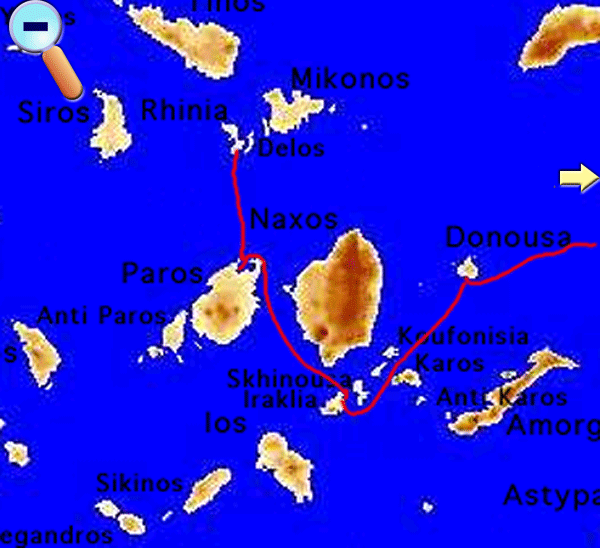
I took a nice long swim and had a snack. Then I raised the anchor and departed for Iraklia. The time of departure was 1305. While in the open sea, I tried to receive e-mail but I was not successful. I did, however, receive an SMS message from Nikos. He too had seen the early forecasts calling for strong S winds and he advised me to go to the main harbor of Paros, Parikia. The latest Navtex reports were calling for force 4-5 and the wind here was just a light breeze of 2-3 knots S which could not even fill the sails. I tried to call Nikos but the signal was fading in and out so that I could barely hear him. It seemed that he got a gale warning last night which was later canceled. No cause for alarm or change of plans. We continued motoring to Iraklia. At least the batteries did get a small amount of charge.
During this passage through the calm sea there was hardly anything to do but lounge on deck and read. I had been reading two books recently: The Beak of the Finch by Jonathan Weiner, which is a fascinating account of recent field research on evolution, and Umberto Eco’s The Island of the Day Before. This book is an amazing compendium of Medieval search for a means to determine longitude but it is extremely slow moving and it is not clear if the story is getting anywhere at all. In many ways it is similar to his Foucault’s Pendulum and nowhere as gripping as his Name of the Rose.
We arrived at Ayios Georgios [36° 52' N 025° 28.3' E], the main port of Iraklia island, at 1710. We had motored for 23.9 M. At the small quay there was only one sailboat, side-to, and next to it there was a good sized space. I put on the fenders and docking lines and approached the space to dock. But the crew from the sailboat informed me that the space was used by a large fishing boat and they invited me to raft on their boat on a second tier. The last thing I wanted was to spend the night next to a smelly fishing boat which would have been the case if I had accepted their kind invitation. So, I thanked them and anchored off-shore at 4-5 m water making sure that Thetis was well clear of the area which would be taken by the ferryboat while maneuvering. There was almost no wind and the water was as flat as a mirror. Thetis was just hanging on her chain.
I spent some time relaxing and reading while sipping an ouzo. The expected fishing boat came in. Her skipper was a middle aged lady who waved at she passed. Later I went ashore for a walk and eventually to eat. I could not get any GSM signal either from afloat or from the village.

Iraklia or Heraklia (Ηρακλειά) is the westernmost of the group of small islands S of Naxos known as the Small Cyclades. It has a cave with stalactites but I have never seen it. There are a few remnants of early Cycladic settlements but they are hard to find. Until 15 years ago the island was one of the most remote places in Greece. It was serviced by a caïque once a week bringing the mail. Alice and I had first come to Iraklia in the fall of 1965. That was the year that we had met, little did we know then that we would get married later. There were no telephones and no electricity. Only one street. The “Street” was paved with cobble stones, the rest were dirt roads. The “President” owned and operated The “Store” and he also, if asked, rented The “Room.” When they wanted to refer to someone as being wealthy they said that “he has shoes.”
Well, now as I walk the main street I pass by The “Room” which is part of a proper and well kept house. Further up I pass The “Store.” I am very glad to see that it still exists and is not too different than the way it used to be. Then, it was the only public place in the village. It functioned as a general store, with very limited supplies, plus kafenio (café) where all the men gathered to sip coffee or wine, play tavli (backgammon), gossip, etc. It also served as the only restaurant for the very rare tourist like ourselves. The “President’s” wife, would bring food from home and serve it to us. I particularly remember one early morning when we arrived to have a cup of coffee. It was dark inside The “Store” illumination, provided by an oil lamp. A magnificent looking old fisherman, the “captain,” was sitting at a table in a corner. He was a large man, with a gray handlebar mustache, and no shoes. He was sipping a large glass of wine. A female voice was heard from the outside: “You lazy good for nothing man, here you are again, drinking, first thing in the morning, you should be out with the boat fishing.” He said nothing. He continued sipping his wine. The voice from the outside continued. After a few minutes, he said in a very calm and measured voice: “Woman, you have said enough, go.” The voice from the outside stopped. He looked at us, smiled, and called out to the “President” “bring me another cup, she has upset me.”
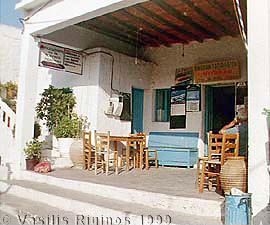
Now The “Store” is a small but proper grocery store lit by electricity, but there are still tables outside and men are still drinking their wine and discussing the state of the world. They are all wearing shoes. Across the street there is a card phone. I called Alice and as she was out I left her a message. I walked some more. There are now at least three restaurants, in addition to The “Store,” which does not seem to function in that capacity anymore. Up the hill, one restaurant, the Pefkos (Pine tree) where we had eaten the last time we had visited the island in 1987, was about to close for the day. Across from it, the Maistrali (Mistral), with a good view of the harbor, was doing a brisk business. I entered and asked what they had to offer and in particular what fish were fresh. They were not very polite and they seemed surprised that I would even ask, so I left. I went to the third restaurant the Periyali (Περιγιάλι - Seashore), which is at the bottom of the hill near the harbor. They were very polite and had octopus and grilled lithrinia (red snappers) which looked very fresh. The lady that served me recognized me. She was the captain of the large fishing boat who had waved when her boat entered the harbor. She is the proprietor’s sister and her boat provides the restaurant with fresh fish. The second waitress, an attractive young woman from the Ukraine, spoke good English to the foreign clientele and was also very polite. It was a very good and pleasant meal.
Back on Thetis I ate the last of the grapes from Kalami. Still no wind and the sea was calm. I was glad that Thetis was off-shore because the quay was illuminated by very high intensity lights which would have prevented me from sleeping well.
Saturday September 18, 1999, Day 7
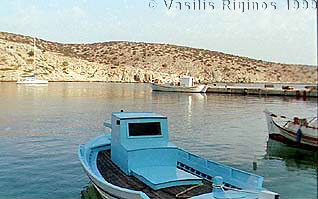
It was an interesting night. There was almost no wind but the mildest breeze from the south. At around 2:30 AM I was woken up by a very strong downpour. I got up, closed all the hatches and raised the spray hood over the companionway. At about 5:00 AM I was woken up again. This time it was the arrival of the ferryboat. Her wake reverberating in the little cove shook Thetis. The ferryboat stayed only 10 minutes or so. After she left I went back to sleep.
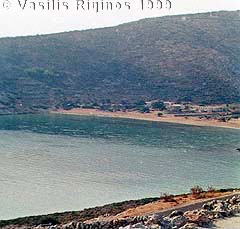
Later in the morning I went ashore for a long hike. I followed the road to Panayia, past Livathdi Beach. It was here back in 1965 where I had accidentally speared my hand while spear-fishing and had to be evacuated to Naxos for treatment. The beach was then a most remote place, now it has a hotel. It looks like it might be a nice anchorage although there is an underwater power cable and it is very shallow close to the shore. From the beach to the village of Panayia is a good uphill walk. The village is attractive and clean with humble houses of Cycladic architecture. It actually has more permanent inhabitants than the port of Ayios Georgios. On my way back, I took an overland path which eventually led me near the church of Ayios Georgios (to avoid getting lost one has to bear left at all cross-paths).
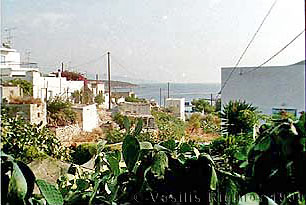
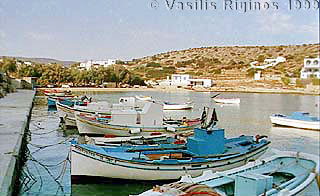
Back on Thetis, after having a swim to cool off in the lovely waters of the cove, I raised the anchor at 1155. The Navtex forecast called for a force 4 to 5 SSW wind. We actually had a SSE wind of about 14-18 knots. As soon as we were outside the cove I raised the mainsail and shook off both reefs. We motor-sailed for a while but as the wind freshened we were able to sail for 12 M, then the wind stopped. After motor-sailing for another half an hour the wind backed to NNW at 8-10 knots which allowed us to sail again all the way to Naoussa, Paros.
We arrived at the bay of Naoussa [37° 08.8' N 25° 13.6' E] at 1510 having covered 26.5 M. I anchored off in the well protected cove of Ayios Ioannis at 7 m without any trouble. It was very calm and peaceful.
Later in the evening the wind came from the S again, at 8-12 knots, then later from the SE, then from SW, then it veered from the NW and N. Very confusing, but the anchor held firmly. For supper I made a pilaf with pine nuts and currants. This I accompanied with some red Parian wine that I had bought in Patmos.
Sunday September 19, 1999, Day 8
Yesterday’s walk must have tired me because I slept well-past 8:00. The sun was very strong but as soon as I put up the tent clouds moved in. I spent most of the morning reading.
Around midday I took the zodiac for an approximate 40 minute ride to the town of Naoussa about 1 M away from Ayios Ioannis. There I took a walk in the picturesque town and the harbor, taking pictures. I also bought some provisions and a most wonderful fresh bread. I did not expect to find bread, today being Sunday when usually the bakeries in Greece are closed. I also managed to get some incoming e-mail. Alice had sent me the new telephone number of Balmar, the makers of the alternator. I will have to wait for tomorrow before calling them. The ride back to Thetis on the zodiac was against the chop and a very wet one. On the way, I passed by a German sailboat, anchored some distance away from Thetis, which was equipped with the same model of Air Marine wind generator as mine. This one, however, was turning happily and was not making too much noise. I stopped and talked to them. They have had the generator for 1½ years which makes it a newer model than mine. They said that it has been working very well and they are happy with it. Being a newer model could account for its quieter operation.
After I got back on Thetis and while having lunch, I kept thinking about the wind generator. Why is mine not working? Have I overlooked something? Is its circuit really OK? After lunch I started tracing the circuit. It was OK. I disconnected the generator cables at the panel switch. This switch has two positions: in position 1 the generator is connected to the battery, in position 2 the generator’s cables are shorted and the generator brakes. Now I untied the generator’s blades, I measured its open circuit voltage while it was turning. It was a correct 14.4 V. Yet when connected to the battery I could not measure any generated current. I tied back its blades and shorted its two leads. When I untied the blades the generator turned for a while and then it braked as it was supposed to. Curious! Could it be that the fuse which was on the positive cable between the generator and the switch was too resistive? I cleaned its contacts, tied the blades, re-connected the switch, and untied the blades. The generator turned in the wind and I threw the switch, it kept on turning. I looked at the fuse. It was burned. It turned out that instead of the original 40 A fuse the electrician had replaced it with a 10 A. I replaced the fuse, and just to be on the safe side and avoid transient currents through the fuse, I moved the fuse holder to the output of the switch. Now the generator braked properly but still there was no charging current going to the battery. Time to trace the cables from the switch to the battery. The positive cable was fine but the negative had a problem. Near the Ah meter’s shunt, the cable was spliced because it was not long enough to reach the shunt. The splice was covered with tape. After removing the tape, I found that the splice was just mechanical and not soldered. Maybe the contact was resistive. Just to make sure, I took a screw-clamp and squeezed the two cables together. Joy! It worked. Now I had a means of charging the battery. Not as much energy as the alternator provided, but while there was wind, enough to cover the consumption. By now the wind was over 25 knots and the battery was receiving about 8 A.
Very satisfied with myself, I decided to celebrate this major victory over a system that has been thwarting my efforts to getting it back working for the past two years, by taking a nice long hike ashore. I put my shoes in a plastic bag and stepped into the zodiac. Then, I remembered that I should take the camera with me because there may be some nice shots. I stepped up into Thetis, took the camera and placed it inside the plastic bag along with the shoes. I then rode the zodiac ashore to a near-by rock. I dropped the little anchor from the stern and while paying out the rope approached the rock. I tied the painter and placed the plastic bag with the camera and shoes on the rock. I then adjusted the anchor line so that the zodiac would not rub on the rock awhile being pushed by the waves and wind. I then stepped on the rock. To my horror the bag had disappeared. After looking around I spotted it in the water. The strong wind must have blown it off the rock while I was adjusting the lines on the zodiac. I immediately retrieved it but by this time the camera had been totally submerged. I rushed it back on Thetis, rinsed it thoroughly with fresh water, and dried it as best as I could. There was nothing more I could do. Very sobered by this, I did go ashore and did take a walk but my heart was not in it.
Later I put the camera and the zoom lens in the warmed oven in an effort to remove all water vapors from its interior mechanisms and from the lens. But I do not have high hopes for its recovery. It was a lovely SLR Nikon 8008 camera with a 35-105 mm zoom lens.
Monday September 20, 1999, Day 9
In the morning there were very strong gusts into the bay. The forecast from the Navtex called for force 5-6 NNE increasing slightly over the next 24 hours. Keeping in mind that I am committed to be at Ft. Lauderdale by October 25 for the Yachtmaster course, I decided to push on for Rhinia to be closer to Glyfada. I raised and lashed down the zodiac, then raised the anchor.
We left Paros at 1015. The wind outside Naoussa Bay was 18-22 knots NNE exactly against our course. The choice was simple: either make long tacks with sails, or motor. I chose to motor. It was slow and uncomfortable, going against the wind and the considerable seas. Plenty of spray. The alternator, after starting the motor, was charging at 16 A but soon dropped down to 7 and then to 4 A. I left the wind generator on. It was noisy but the service battery needed the charge. Slowly, ever so slowly, the amp-hour deficit was reduced. I felt almost sick every time I thought of the camera. To make matters worse, during a violent jerk I tore my fingernail and it started to bleed. Beat, beat, beat, we were making slow progress while I was crouched under the spray hood. Uncomfortable but not too bad.
After 18.1 slow miles we arrived at Rhinia at 1500. We entered the South Cove [37° 23.1' N 25° 14.4' E]) and anchored on the east side at 3.5 m, letting out over 30 m of chain. Other than the strong, 30 knots gusts, there was no problem. The water was fairly calm. The windows of the main cabin were of course leaking quite a lot. The wind generator has been behaving well. I adjusted its output voltage at 14.8 V to accommodate the new deep discharge service battery.
I spent the rest of the afternoon reading. My finger nail did hurt quite a bit. I decided to stay here until the weather improved and then go to Syros and see if I can do something about the alternator. There were no other boats and I had the cove all to myself. I was luxuriating in this wonderful solitude. The barometer had increased from 1009 this morning to 1011 mB. The latest Navtex weather report predicted for both Southwest Aegean and the Kafireas Strait force 6 winds decreasing gradually tomorrow. In the meantime, here the wind was a solid force 7.
In the evening the wind subsided somewhat. Before going to bed I switched the wind generator off so that I could sleep in peace without its infernal noise.
Tuesday September 21, 1999, Day 10
Sometime after midnight the wind came back with a vengeance. The gusts were over 30 knots, and it was howling the rest of the night. As the wind direction was not steady I was somewhat concerned that a strong gust from either the east or the west could push Thetis towards the rocks, as I had left a rather large length of chain, but there was no problem, just my own paranoia.
In the morning I turned on the wind generator and it quickly replenished the power that was consumed during the night. While the Navtex was reporting an alarming low front over Italy moving east, here the barometric pressure had been holding steady at 1012 mB. The forecast was not very different from yesterday’s but it did not mention any attenuation of the winds. During the morning the wind was averaging around 30 knots but with much higher gusts. The water, although calm, was creased with wavelets and was not inviting. Despite the strong sun it felt cold on deck.
I prepared the second anchor which amazingly had not been used this whole season. During the spring it and its chain had been re-galvanized, so now I had to re-connect them with their shackles (κλειδιά) which had to be secured with stainless steel safety wires from coming loose. After the anchor and its chain were ready, I let out, at the bow, 20 more meters of ground tackle and then I dropped the second anchor from the stern. Then with the windlass, slowly against the violent winds, I pulled back these 20 m of ground tackle. After that, I pulled the stern line taut. Now there was no more question on security. The second anchor would not only stabilize the wild swings of the boat, caused by the gusts and prevent her from approaching the rocks, but it would also keep the bow anchor from being dislodged. I snorkeled and checked both anchors. They were both perfectly set, buried deeply under the sand. I then swam ashore and sunbathed but it was not comfortable because the wind blew the soft sand and I was being sandblasted.
In the afternoon another sailboat came and anchored on the W side of the cove but they did not stay very long. I wanted to go ashore for a walk but I had not launched the zodiac and it was still lashed on deck. On a second thought, it did not seem prudent to launch it with this strong wind, so instead of a walk I occupied myself with updating various files on the computer. The GSM signal here was very weak.
In the late evening the wind was down somewhat, to 17 knots. I cooked some pasta for dinner. The new Navtex weather forecast predicted attenuation of the winds starting tomorrow. The night was pleasant and quiet with the moon being reflected on the now calm waters of the cove. I listened to music and read.
The total distance we traveled from Pythagorio, Samos to Rhinia was 165 M and 30.5 travel hours.